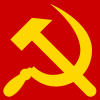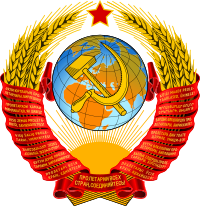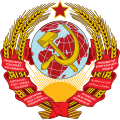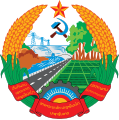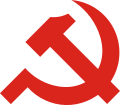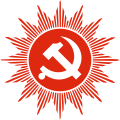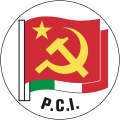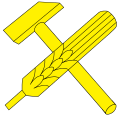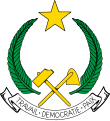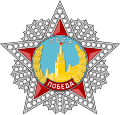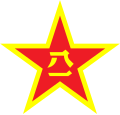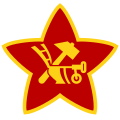
The State Flag of the Union of Soviet Socialist Republics, or simply the Soviet flag, was a red banner with two communist symbols displayed in the canton: a gold hammer and sickle topped off by a red five-point star bordered in gold. The flag's design and symbolism are derived from several sources, but emerged during the Russian Revolution. It has also come to serve as the standard symbol representing communism as a whole, recognized as such in international circles, even after the dissolution of the Soviet Union in 1991.

The hammer and sickle is a communist symbol representing proletarian solidarity between agricultural and industrial workers. It was first adopted during the Russian Revolution at the end of World War I, the hammer representing workers and the sickle representing the peasants.

In politics, a red flag is predominantly a symbol of left-wing politics, including socialism, communism, Marxism, labour movement, and anarchism. The originally empty or plain red flag has been associated with left-wing politics since the French Revolution (1789–1799).

The national emblem of Belarus features a ribbon in the colors of the national flag, a silhouette of Belarus, wheat ears and a red star. It is sometimes referred to as the coat of arms of Belarus, although in heraldic terms this is inaccurate as the emblem does not respect the rules of conventional heraldry. The emblem is an allusion to one that was used by the Byelorussian SSR, designed by Ivan Dubasov in 1950, with the biggest change being a replacement of the Communist hammer and sickle with a silhouette of Belarus. The Belarusian name is Dziaržaŭny hierb Respubliki Biełaruś, and the name in Russian is Gosudarstvennyĭ gerb Respubliki Belarusʹ.

The national emblem of East Germany featured a hammer and a compass, surrounded by a ring of rye. It was an example of what has been called "socialist heraldry". It was the only heraldic device of a European socialist state with a ring of grain which does not contain a red star.

A red star, five-pointed and filled, is a symbol that has often historically been associated with communist ideology, particularly in combination with the hammer and sickle, but is also used as a purely socialist symbol in the 21st century. It has been widely used in flags, state emblems, monuments, ornaments, and logos.

The state emblem of Uzbekistan was formally adopted on July 2, 1992, by the newly establish Republic of Uzbekistan. It bears many similarities to the emblem of the previous Uzbek Soviet Socialist Republic (SSR), which Republic of Uzbekistan succeeded. Like other post-Soviet republics whose symbols do not predate the October Revolution, the current emblem retains some components of the Soviet one. Prior to 1992, Uzbekistan had an emblem similar to all other Soviet Republics, with standard communist emblems and insignia.
Transnistria is a region in Eastern Europe that is under the effective control of the Russian-backed Pridnestrovian Moldovan Republic but is recognized by the international community as an administrative unit of Moldova, the Administrative-Territorial Units of the Left Bank of the Dniester. The flag of the Pridnestrovian Moldovan Republic is a red-green-red triband, while the Administrative-Territorial Units of the Left Bank of the Dniester use the flag of Moldova.

The Byelorussian SSR emblem was used as the coat of arms of the Soviet Socialist Republic until the fall of the Soviet Union. The coat of arms is based on the coat of arms of the Soviet Union.

The coat of arms of the Georgian Soviet Socialist Republic was adopted on May 20, 1921 by the government of the Georgian Soviet Socialist Republic. The coat of arms is loosely based on the coat of arms of the Soviet Union. It shows symbols of agriculture. The red star rising above the Caucasus stands for the future of the Georgian nation, and the hammer and sickle for the victory of Communism and the "world-wide socialist community of states".

The coat of arms of the Kazakh Soviet Socialist Republic was adopted on March 26, 1937, by the government of the Kazakh Soviet Socialist Republic. The coat of arms is based on the coat of arms of the Soviet Union.

The coat of arms of the Kirghiz Soviet Socialist Republic was adopted on March 23, 1937, by the government of the Kirghiz Soviet Socialist Republic. The coat of arms is based on the coat of arms of the Soviet Union. It shows symbols of agriculture on a backdrop of the Ala-Too mountain ranges, surrounded by a frame of folk art of the Kyrgyz people. The red star was added in 1948. The rising sun stands for the future of the Kyrgyz nation, the star as well as the hammer and sickle for the victory of communism and the "worldwide socialist community of states".

The State Emblem of the Tajik Soviet Socialist Republic was adopted on March 1, 1937 by the government of the Tajik Soviet Socialist Republic. The emblem is based on the State Emblem of the Soviet Union. It shows symbols of agriculture. The red star is prominently featured with a small hammer and sickle within it. The rising sun stands for the future of the Tajik nation, and the star as well as the hammer and sickle for the victory of communism and the "world-wide socialist community of states". The emblem was replaced with the new emblem in 1992, which uses a similar design to the Soviet one. It was, however, was replacing the red banner with the current national flag, the big red star was replaced by the mountains, represents Pamir, the Samanid dynasty crown, and added the Quran book at below. It represents Islam as the official religion.

The coat of arms of the Moldavian Soviet Socialist Republic was adopted on 10 February 1941 by the government of the Moldavian Soviet Socialist Republic. The coat of arms is based on the coat of arms of the Soviet Union. It shows symbols of agriculture, an outer rim featuring wheat, corn, grapes and clover. The red banner bears the Soviet Union state motto in both the Romanian language and the Russian language. In Romanian, it was initially "Пролетарь дин тоате цэриле, униць-вэ!"; then, from the 1950s "Пролетарь дин тоате цэриле, уници-вэ!". Both are written in the Latin alphabet as "Proletari din toate țările, uniți-vă!". The acronym MSSR is shown only in Romanian in Moldovan Cyrillic ("РССМ"). The emblem was replaced on 3 November 1990 by the present coat of arms of Moldova. Currently, the unrecognized breakaway state of Transnistria uses a similar state emblem.
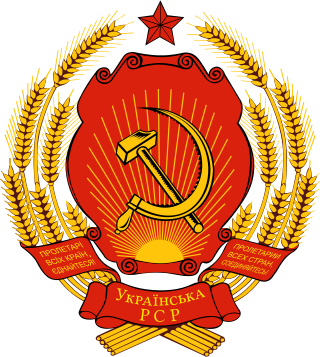
The coat of arms of the Ukrainian Soviet Socialist Republic was adopted on 14 March 1919 by the government of the Ukrainian Soviet Socialist Republic and subsequently modified on 7 November 1928, 30 January 1937 and 21 November 1949. The coat of arms from 1949 is based on the coat of arms of the Soviet Union and features the hammer and sickle, the red star, a sunrise and stalks of wheat on its outer rims. The rising sun stands for the future of the Soviet Ukrainian nation, the red star as well as the hammer and sickle for communism and the "world-wide socialist community of states".

Socialist-style emblems usually follow a unique style consisting of communist symbolism. Although commonly referred to as coats of arms, most are not actually traditional heraldic achievements. Many communist governments purposely diverged from heraldic tradition in order to distance themselves from the monarchies that they usually replaced, with coats of arms being seen as symbols of the monarchs.
The coat of arms of the Moldavian Autonomous Soviet Socialist Republic was the official emblem of the Moldavian Autonomous Soviet Socialist Republic in the Soviet Union, and underwent a number of changes over time.

The State Emblem of the Soviet Union was adopted in 1923 and was used until the dissolution of the Soviet Union in 1991. Although it technically is an emblem rather than a coat of arms, since it does not follow traditional heraldic rules, in Russian it is called герб, the word used for a traditional coat of arms.

The emblem of the Russian Soviet Federative Socialist Republic (RSFSR) was adopted on 10 July 1918 by the government of the Russian Soviet Federative Socialist Republic, and modified several times afterwards. It shows wheat as the symbol of agriculture, a rising sun for the future of the Russian nation, the red star as well as the hammer and sickle for the victory of communism and the "world-wide socialist community of states".
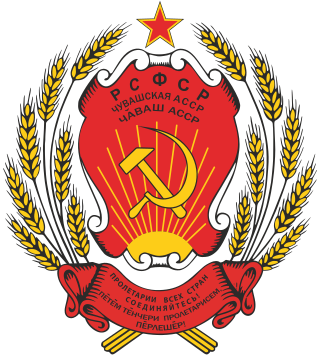
The national emblem of the Chuvash Autonomous Soviet Socialist Republic was adopted in 1937 by the government of the Chuvash Autonomous Soviet Socialist Republic. The emblem is identical to the emblem of the Russian Soviet Federative Socialist Republic.

